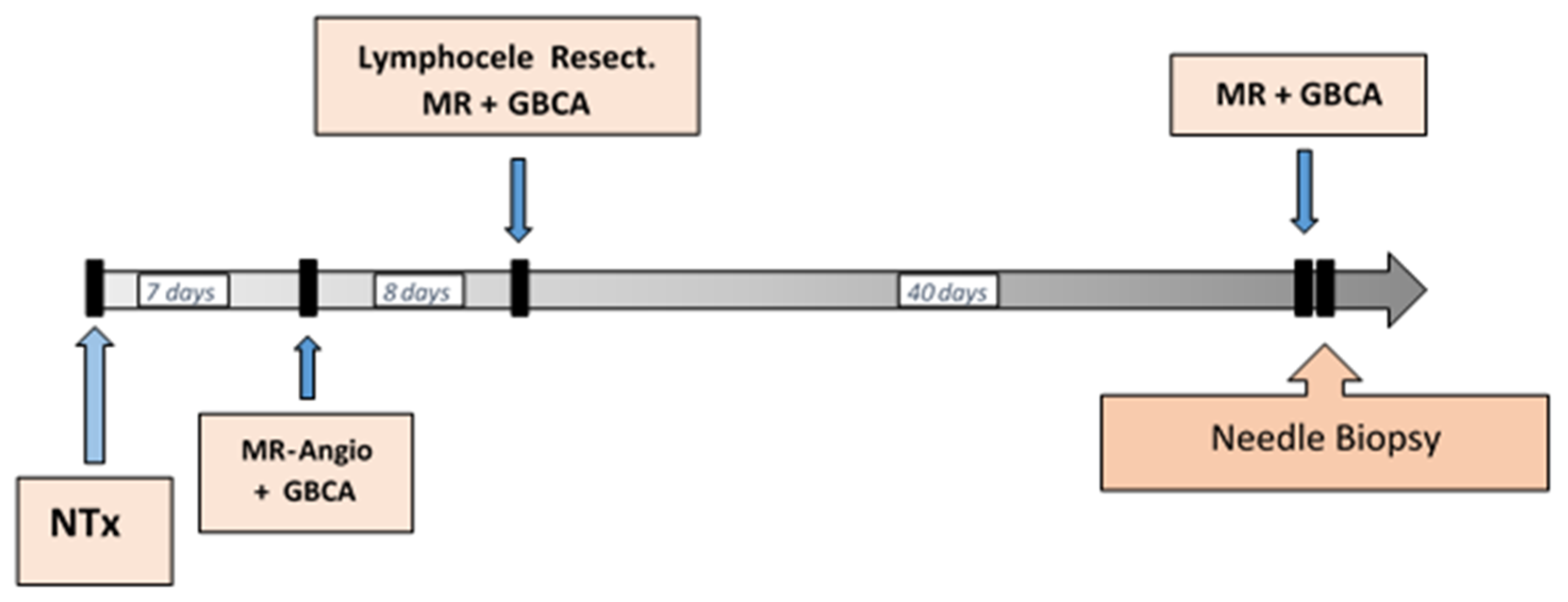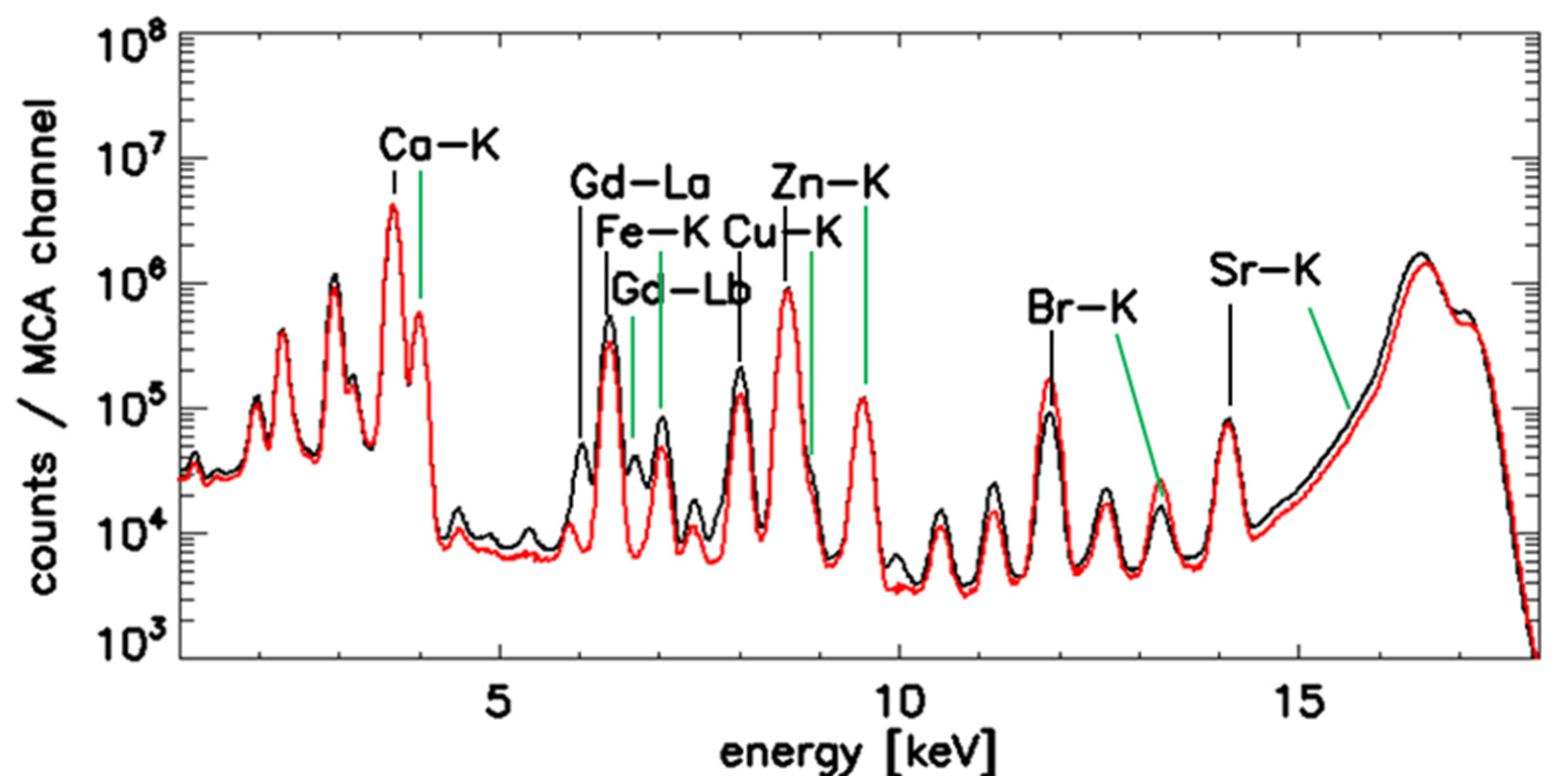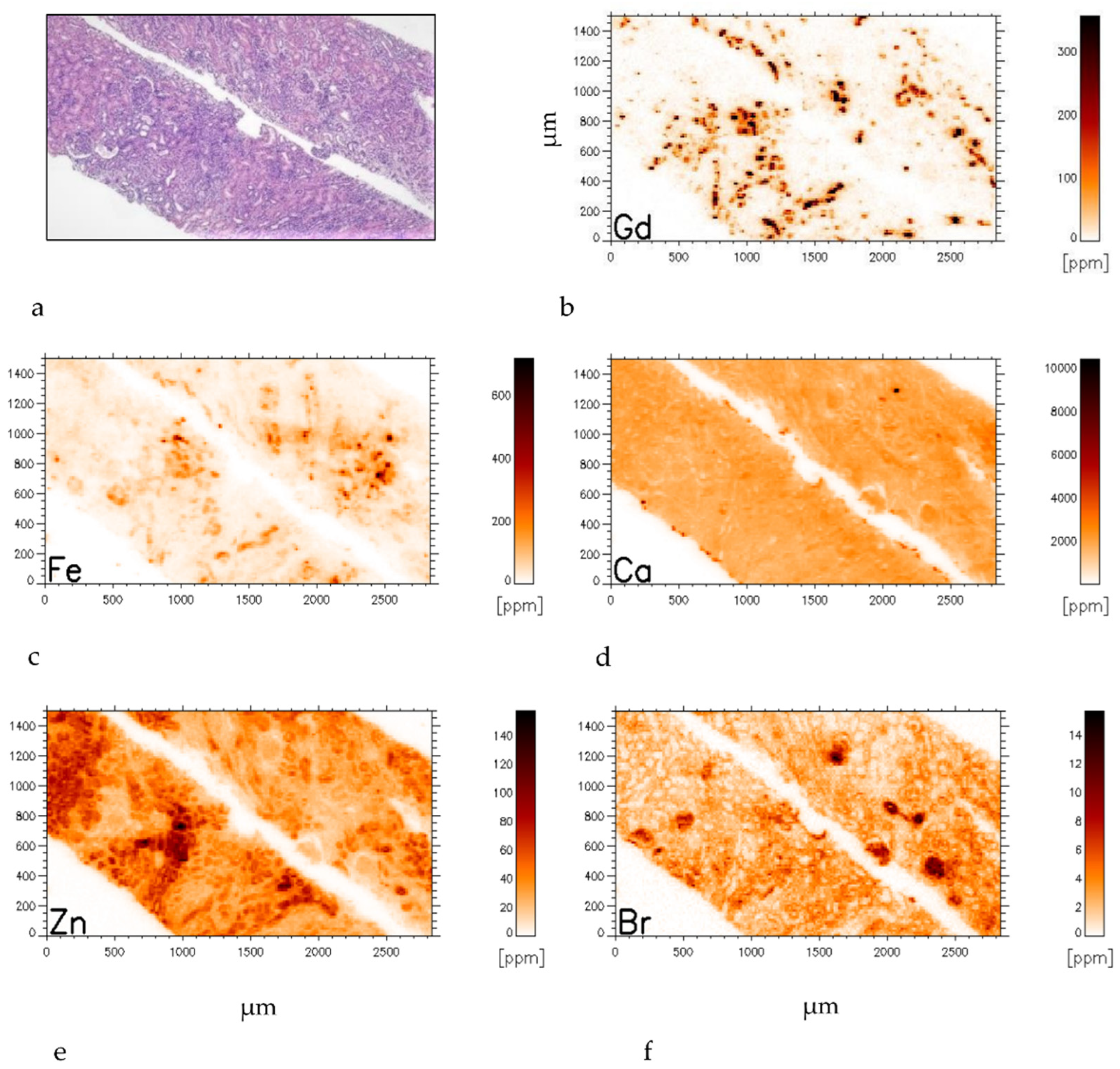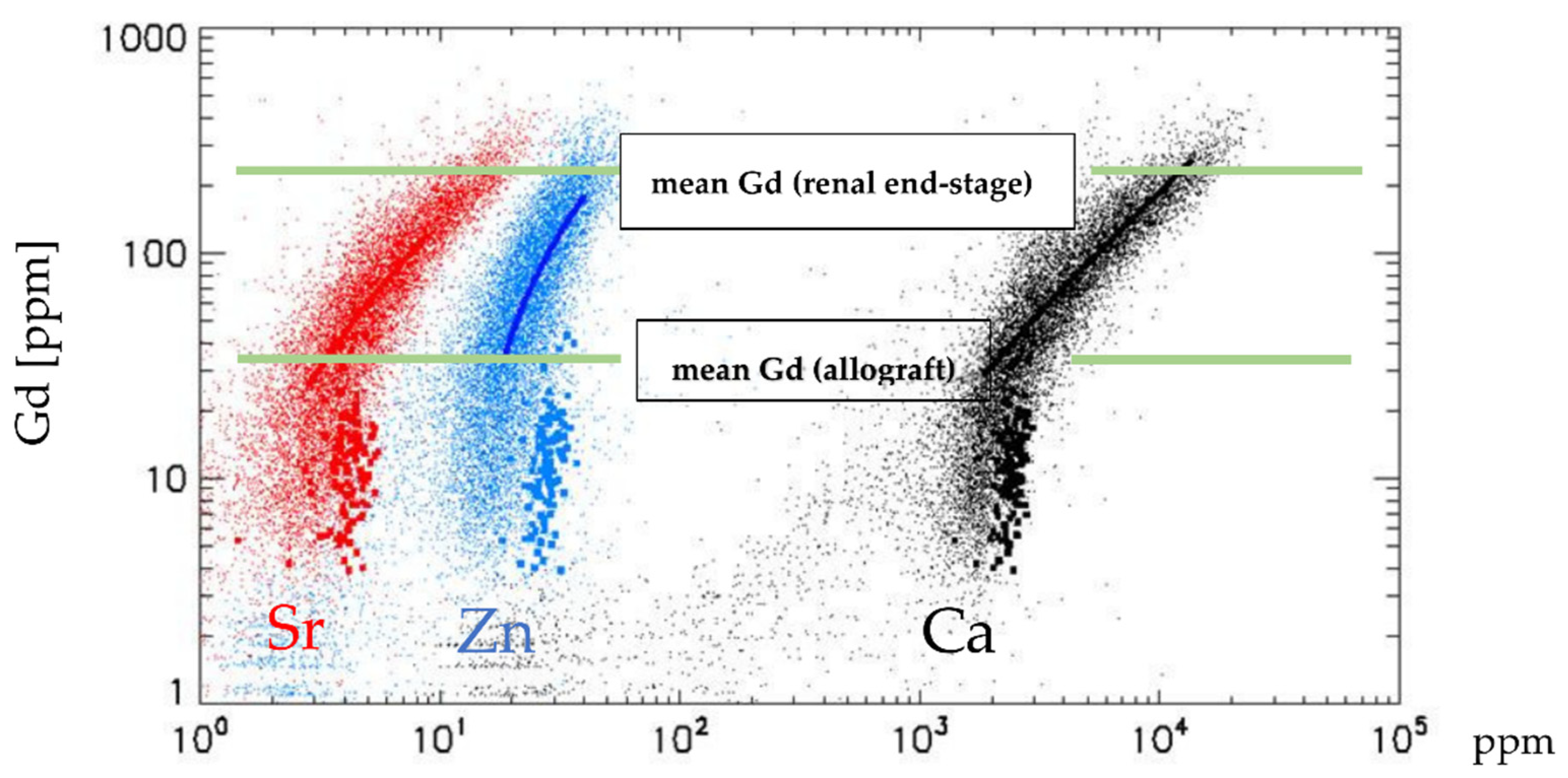Gadolinium and Bio-Metal Association: A Concentration Dependency Tested in a Renal Allograft and Investigated by Micro-Synchrotron XRF
Abstract
1. Introduction
2. Materials and Methods
2.1. Control Kidney Tissue (C-KT)
2.2. Patient and Tissue Specimen (P-KT)
2.3. Tissue Preparation for µSRXRF Investigation
2.4. Microscopic Synchrotron Radiation X-ray Fluorescence Analysis
2.5. Quantification of Elements
2.6. Statistical Analysis
3. Results
4. Discussion
Author Contributions
Funding
Institutional Review Board Statement
Informed Consent Statement
Data Availability Statement
Conflicts of Interest
Abbreviations
| GBCA | Gadolinium-based contrast agents |
| Gd | Gadolinium |
| SRXRF | Synchrotron X-ray fluorescence |
| NSF | Nephrogenic systemic fibrosis |
References
- Grobner, T.; Prischl, F.C. Gadolinium and nephrogenic systemic fibrosis. Kidney Int. 2007, 72, 260–264. [Google Scholar] [CrossRef] [PubMed]
- Bruder, O.; Schneider, S.; Nothnagel, D.; Pilz, G.; Lombardi, M.; Sinha, A.; Wagner, A.; Dill, T.; Frank, H.; van Rossum, A.; et al. Acute adverse reactions to gadolinium-based contrast agents in CMR: Multicenter experience with 17,767 patients from the EuroCMR Registry. JACC Cardiovasc. Imaging 2011, 4, 1171–1176. [Google Scholar] [CrossRef] [PubMed]
- Cowper, S.E.; Su, L.D.; Bhawan, J.; Robin, H.S.; LeBoit, P.E. Nephrogenic fibrosing dermopathy. Am. J. Dermatopathol. 2001, 23, 383–393. [Google Scholar] [CrossRef] [PubMed]
- Grobner, T. Gadolinium—A specific trigger for the development of nephrogenic fibrosing dermopathy and nephrogenic systemic fibrosis? Nephrol. Dial. Transplant. 2006, 21, 1104–1108. [Google Scholar] [CrossRef]
- Akgun, H.; Gonlusen, G.; Cartwright, J., Jr.; Suki, W.N.; Truong, L.D. Are gadolinium-based contrast media nephrotoxic? A renal biopsy study. Arch. Pathol. Lab. Med. 2006, 130, 1354–1357. [Google Scholar] [CrossRef] [PubMed]
- High, W.A.; Ayers, R.A.; Chandler, J.; Zito, G.; Cowper, S.E. Gadolinium is detectable within the tissue of patients with nephrogenic systemic fibrosis. J. Am. Acad. Dermatol. 2007, 56, 21–26. [Google Scholar] [CrossRef]
- High, W.A.; Ayers, R.A.; Cowper, S.E. Gadolinium is quantifiable within the tissue of patients with nephrogenic systemic fibrosis. J. Am. Acad. Dermatol. 2007, 56, 710–712. [Google Scholar] [CrossRef]
- Layne, K.A.; Dargan, P.I.; Archer, J.R.H.; Wood, D.M. Gadolinium deposition and the potential for toxicological sequelae—A literature review of issues surrounding gadolinium-based contrast agents. Br. J. Clin. Pharmacol. 2018, 84, 2522–2534. [Google Scholar] [CrossRef]
- Rahatli, F.K.; Donmez, F.Y.; Kibaroglu, S.; Kesim, C.; Haberal, K.M.; Turnaoglu, H.; Agildere, A.M. Does renal function affect gadolinium deposition in the brain? Eur. J. Radiol. 2018, 104, 33–37. [Google Scholar] [CrossRef]
- Wadas, T.J.; Sherman, C.D.; Miner, J.H.; Duncan, J.R.; Anderson, C.J. The biodistribution of [153Gd]Gd-labeled magnetic resonance contrast agents in a transgenic mouse model of renal failure differs greatly from control mice. Magn. Reson. Med. 2010, 64, 1274–1280. [Google Scholar] [CrossRef]
- Sato, T.; Ito, K.; Tamada, T.; Kanki, A.; Watanabe, S.; Nishimura, H.; Tanimoto, D.; Higashi, H.; Yamamoto, A. Tissue gadolinium deposition in renally impaired rats exposed to different gadolinium-based MRI contrast agents: Evaluation with inductively coupled plasma mass spectrometry (ICP-MS). Magn. Reson. Imaging 2013, 31, 1412–1417. [Google Scholar] [CrossRef]
- Rogosnitzky, M.; Branch, S. Gadolinium-based contrast agent toxicity: A review of known and proposed mechanisms. Biometals 2016, 29, 365–376. [Google Scholar] [CrossRef]
- Tweedle, M.F.; Hagan, J.J.; Kumar, K.; Mantha, S.; Chang, C.A. Reaction of gadolinium chelates with endogenously available ions. Magn. Reson. Imaging 1991, 9, 409–415. [Google Scholar] [CrossRef]
- Puttagunta, N.R.; Gibby, W.A.; Smith, G.T. Human in vivo comparative study of zinc and copper transmetallation after administration of magnetic resonance imaging contrast agents. Investig. Radiol. 1996, 31, 739–742. [Google Scholar] [CrossRef]
- Abraham, J.L.; Thakral, C.; Skov, L.; Rossen, K.; Marckmann, P. Dermal inorganic gadolinium concentrations: Evidence for in vivo transmetallation and long-term persistence in nephrogenic systemic fibrosis. Br. J. Dermatol. 2008, 158, 273–280. [Google Scholar] [CrossRef]
- Thakral, C.; Abraham, J.L. Gadolinium-induced nephrogenic systemic fibrosis is associated with insoluble Gd deposits in tissues: In vivo transmetallation confirmed by microanalysis. J. Cutan. Pathol. 2009, 36, 1244–1254. [Google Scholar] [CrossRef]
- Osterode, W.; Falkenberg, G.; Regele, H. Gadolinium distribution in kidney tissue determined and quantified by micro synchrotron X-ray fluorescence. Biometals 2021, 34, 341–350. [Google Scholar] [CrossRef]
- Osterode, W.; Falkenberg, G.; Ferenci, P.; Wrba, F. Quantitative trace element mapping in liver tissue from patients with Wilson’s disease determined by micro X-ray fluorescence. J. Trace Elem. Med. Biol. 2019, 51, 42–49. [Google Scholar] [CrossRef]
- Falkenberg, G.; Osterode, W. Räumliche Abbildung der Verteilung von Spurenelementen auf mikroskopischem Niveau. Wo sitrzt das Blei im Knochen? Mikoroskopischen Röntgenfluoreszenzanalyse. In Forschung mit Synchrotronstrahlung; Falta, J., Möller, T., Eds.; Vieweg + Teubner: Wiesbaden, Germany, 2010. [Google Scholar]
- Vekemans, B.; Janssens, K.; Vince, L.; Adams, F.; Van Espen, P. Analysis of X-Ray spectra by iterative least squares (AXIL). New developments. X-ray Spectrum. 1994, 23, 278–285. [Google Scholar] [CrossRef]
- Osterode, W.; Falkenberg, G.; Höftberger, R.; Wrba, F. Iron, copper, zinc and bromine mapping in cirrhotic liver slices from patients with hemochromatosis studied by microscopic synchrotron radiation X-ray fluorescence analysis in continuous scanning mode. Spectrochim. Acta Part B 2007, 62, 682–688. [Google Scholar] [CrossRef]
- Osterode, W.; Falkenberg, G.; Wrba, F. Copper and Trace Elements in Gallbladder form Patients with Wilson’s Disease Imaged and Determined by Synchrotron X-ray Fluorescence. J. Imaging 2021, 7, 261. [Google Scholar] [CrossRef] [PubMed]
- McDonald, R.J.; McDonald, J.S.; Kallmes, D.F.; Jentoft, M.E.; Paolini, M.A.; Murray, D.L.; Williamson, E.E.; Eckel, L.J. Gadolinium Deposition in Human Brain Tissues after Contrast-enhanced MR Imaging in Adult Patients without Intracranial Abnormalities. Radiology 2017, 285, 546–554. [Google Scholar] [CrossRef] [PubMed]
- McDonald, R.J.; McDonald, J.S.; Dai, D.; Schroeder, D.; Jentoft, M.E.; Murray, D.L.; Kadirvel, R.; Eckel, L.J.; Kallmes, D.F. Comparison of Gadolinium Concentrations within Multiple Rat Organs after Intravenous Administration of Linear versus Macrocyclic Gadolinium Chelates. Radiology 2017, 285, 536–545. [Google Scholar] [CrossRef]
- Roberts, D.R.; Lindhorst, S.M.; Welsh, C.T.; Maravilla, K.R.; Herring, M.N.; Braun, K.A.; Thiers, B.H.; Davis, W.C. High Levels of Gadolinium Deposition in the Skin of a Patient with Normal Renal Function. Investig. Radiol. 2016, 51, 280–289. [Google Scholar] [CrossRef]
- Wang, S.; Hesse, B.; Roman, M.; Stier, D.; Castillo-Michel, H.; Cotte, M.; Suuronen, J.P.; Lagrange, A.; Radbruch, H.; Paul, F.; et al. Increased Retention of Gadolinium in the Inflamed Brain After Repeated Administration of Gadopentetate Dimeglumine: A Proof-of-Concept Study in Mice Combining ICP-MS and Micro- and Nano-SR-XRF. Investig. Radiol. 2019, 54, 617–626. [Google Scholar] [CrossRef]
- Bussi, S.; Coppo, A.; Botteron, C.; Fraimbault, V.; Fanizzi, A.; De Laurentiis, E.; Colombo Serra, S.; Kirchin, M.A.; Tedoldi, F.; Maisano, F. Differences in gadolinium retention after repeated injections of macrocyclic MR contrast agents to rats. J. Magn. Reson Imaging 2018, 47, 746–752. [Google Scholar] [CrossRef]
- Sanyal, S.; Marckmann, P.; Scherer, S.; Abraham, J.L. Multiorgan gadolinium (Gd) deposition and fibrosis in a patient with nephrogenic systemic fibrosis—An autopsy-based review. Nephrol. Dial. Transplant. 2011, 26, 3616–3626. [Google Scholar] [CrossRef]
- Wagner, B.; Drel, V.; Gorin, Y. Pathophysiology of gadolinium-associated systemic fibrosis. Am. J. Physiol. Renal. Physiol. 2016, 311, F1–F11. [Google Scholar] [CrossRef]
- Idee, J.M.; Fretellier, N.; Robic, C.; Corot, C. The role of gadolinium chelates in the mechanism of nephrogenic systemic fibrosis: A critical update. Crit. Rev. Toxicol. 2014, 44, 895–913. [Google Scholar] [CrossRef]
- George, S.J.; Webb, S.M.; Abraham, J.L.; Cramer, S.P. Synchrotron X-ray analyses demonstrate phosphate-bound gadolinium in skin in nephrogenic systemic fibrosis. Br. J. Dermatol. 2010, 163, 1077–1081. [Google Scholar] [CrossRef]
- Perrin, L.; Carmona, A.; Roudeau, S.; Ortega, R. Evaluation of sample preparation methods for single cell quantitative elemental imaging using proton or synchrotron radiation focused beams. J. Anal. At. Spectrom. 2015, 30, 2525–2532. [Google Scholar] [CrossRef]
- Surowka, A.D.; Gianoncelli, A.; Birarda, G.; Sala, S.; Cefarin, N.; Matruglio, A.; Szczerbowska-Boruchowska, M.; Ziomber-Lisiak, A.; Vaccari, L. Soft X-ray induced radiation damage in thin freeze-dried brain samples studied by FTIR microscopy. J. Synchrotron Radiat. 2020, 27, 1218–1226. [Google Scholar] [CrossRef]
- Jin, Q.; Paudesku, T.; Lai, B.; Gleber, S.C.; Chen, S.; Finney, L.; Vine, D.; Vogt, S.; Woloschak, G.; Jacobsen, C. Preserving elemental content in adherent mammalian cells for analysis by synchrotron-based X-ray fluorescence microscopy. J. Microscopy 2017, 265, 81–93. [Google Scholar] [CrossRef] [PubMed]





| Element [ppm] | Gd | Ca | Zn | Fe | Sr | Cu |
|---|---|---|---|---|---|---|
| mean | <LLD | 2001 | 41 | 35 | 5 | 8 |
| SD | <LLD | 978 | 16 | 21 | 3 | 4 |
| Max | <LLD | 7266 | 123 | 237 | 11 | 35 |
| Element (ppm) | Gd | Ca | Zn | Fe | Sr | Cu |
|---|---|---|---|---|---|---|
| mean | 24 | 1868 | 31 | 39 | 2 | 9 |
| SD | 55 | 726 | 20 | 41 | 1 | 22 |
| Max | 2363 | 10,449 | 157 | 720 | 38 | 964 |
Publisher’s Note: MDPI stays neutral with regard to jurisdictional claims in published maps and institutional affiliations. |
© 2022 by the authors. Licensee MDPI, Basel, Switzerland. This article is an open access article distributed under the terms and conditions of the Creative Commons Attribution (CC BY) license (https://creativecommons.org/licenses/by/4.0/).
Share and Cite
Osterode, W.; Falkenberg, G.; Regele, H. Gadolinium and Bio-Metal Association: A Concentration Dependency Tested in a Renal Allograft and Investigated by Micro-Synchrotron XRF. J. Imaging 2022, 8, 254. https://doi.org/10.3390/jimaging8100254
Osterode W, Falkenberg G, Regele H. Gadolinium and Bio-Metal Association: A Concentration Dependency Tested in a Renal Allograft and Investigated by Micro-Synchrotron XRF. Journal of Imaging. 2022; 8(10):254. https://doi.org/10.3390/jimaging8100254
Chicago/Turabian StyleOsterode, Wolf, Gerald Falkenberg, and Heinz Regele. 2022. "Gadolinium and Bio-Metal Association: A Concentration Dependency Tested in a Renal Allograft and Investigated by Micro-Synchrotron XRF" Journal of Imaging 8, no. 10: 254. https://doi.org/10.3390/jimaging8100254
APA StyleOsterode, W., Falkenberg, G., & Regele, H. (2022). Gadolinium and Bio-Metal Association: A Concentration Dependency Tested in a Renal Allograft and Investigated by Micro-Synchrotron XRF. Journal of Imaging, 8(10), 254. https://doi.org/10.3390/jimaging8100254






